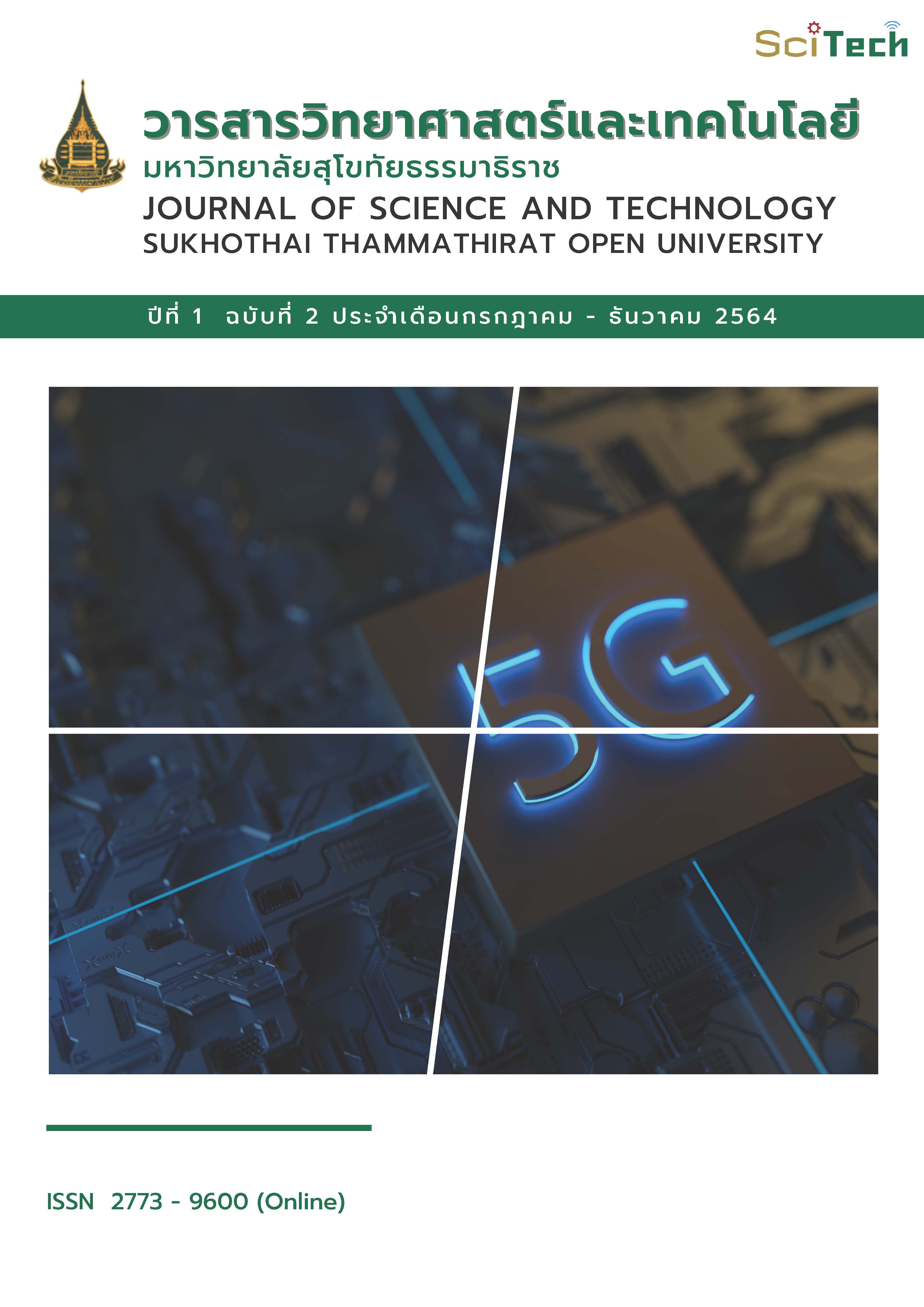การศึกษาอุณหภูมิและโครงสร้างจุลภาคของกระบวนการเคลือบอลูมิเนียมลงบนเซรามิกด้วยแรงเสียดทาน
คำสำคัญ:
การเคลือบด้วยแรงเสียดทาน, อลูมิเนียม, เซรามิกบทคัดย่อ
งานวิจัยนี้ได้ทำการศึกษาโครงสร้างจุลภาคและอุณหภูมิที่เกิดขึ้นระหว่างกระบวนการเคลือบอลูมิเนียม AA1100 ลงบนแผ่นเซรามิกที่ผลิตจากดินขาวด้วยกระบวนการเคลือบด้วยแรงเสียดทาน โดยทำการเคลือบที่ความเร็วรอบมีค่าเท่ากับ 8000 รอบต่อนาที่ อัตราป้อนตามแนวแกนของวัสดุเติมมีค่าเท่ากับ 0.6 มิลลิเมตรต่อนาทื, ระยะป้อนปฐมภูมิมีค่าเท่ากับ 0.5 มิลลิเมตร, อัตราป้อนในแนวระนาบมีค่าเท่ากับ 3 มิลลิเมตรต่อนาที และมุมในการเคลือบมีค่าเท่ากับ 11 องศา โดยผลการทดลองแสดงให้เห็นความประสบความสำเร็จในการเคลือบ โดยไม่เกิดการแตกร้าวระหว่างกระบวนการ ชั้นผิวเคลือบอลูมิเนียมสามารถยึดติดกับแผ่นเซรามิกได้อย่างแข็งแรงไม่เกิดการหลุดลอก ผลจากการศึกษาขนาดและพฤติกรรมของอุณหภูมิที่เกิดขึ้นระหว่างกระบวนการเคลือบพบว่าอุณหภูมิเฉลี่ยของกระบวนการเคลือบมีค่าเท่ากับ 170.3 องศาเซลเซียสซึ่งอุณหภูมิดังกล่าวอยู่ในช่วงอุณหภูมิขึ้นรูปเย็น พฤติกรรมของอุณหภูมิมีลักษณะขึ้นลงอย่างรวดเร็วและต่อเนื่องไปจนกระทั่งสิ้นสุดกระบวนการ อันเป็นผลจากปรากฏการณ์ติดลื่น จากการตรวจสอบโครงสร้างจุลภาคพบว่าหลักฐานแสดงให้เห็นถึงเนื้อของวัสดุเติมที่ผ่านกระบวนการเลื่อนหลุดและสะสมตัวกันจนกลายเป็นชั้นผิวเคลือบ นอกจากนี้เมื่อพิจารณาความหนาของชั้นผิวเคลือบพบว่าชั้นผิวเคลือบมีความหนาเฉลี่ยเท่ากับ 1.168 ไมโครเมตร
เอกสารอ้างอิง
Arai, K., Nishimoto, S., Romanjek, K., Komasaki, M., Nagatomo, Y., & Kuromitsu, Y. (2019). Development of High-Durability Substrates for Thermoelectric Modules. Journal of Electronic Materials, 48(4), 1976-1980.
Bedford, G. M., Vitanov, V. I., & Voutchkov, I. I. (2001). On the thermo-mechanical events during friction surfacing of high-speed steels. Surface and Coatings Technology, 141(1), 34-39.
Camilleri, D. (2012). Thermo‐mechanical behaviour of DBC substrate assemblies subject to soldering fabrication processes. Soldering & surface mount technology.
Dong, G., Chen, X., Zhang, X., Ngo, K. D., & Lu, G. Q. (2010). Thermal fatigue behaviour of Al2O3-DBC substrates under high temperature cyclic loading. Soldering & surface mount technology.
Fukakusa, K. (1996). On the characteristics of the rotational contact plane‐a fundamental study of friction surfacing. Welding International, 10(7), 524-529.
Gandra, J., Miranda, R. M., & Vilaça, P. (2012). Performance analysis of friction surfacing. Journal of Materials Processing Technology, 212(8), 1676-1686.
Gandra, J., Krohn, H., Miranda, R. M., Vilaça, P., Quintino, L., & Dos Santos, J. F. (2014). Friction surfacing—A review. Journal of Materials Processing Technology, 214(5), 1062-1093.
He, H., Fu, R., Wang, D., Song, X., & Jing, M. (2007). A new method for preparation of direct bonding copper substrate on Al2O3. Materials Letters, 61(19-20), 4131-4133.
Hsueh, C. H., & Evans, A. G. (1985). Residual stresses in meta/ceramic bonded strips. Journal of the American Ceramic Society, 68(5), 241-248.
Jiménez, A. E., & Bermúdez, M. D. (2011). Friction and wear. In Tribology for Engineers (pp. 33-63). Woodhead Publishing.
Kovács-Csetényi, E. (1964). Electrical resistivity change in cold-worked tungsten wires during recovery and recrystallization. Acta Physica Academiae Scientiarum Hungaricae, 18(1), 11-18.
Kraft, S., Schletz, A., & Maerz, M. (2012, March). Reliability of silver sintering on DBC and DBA substrates for power electronic applications. In 2012 7th International Conference on Integrated Power Electronics Systems (CIPS) (pp. 1-6). IEEE.
Lee, S. K., Lee, J. H., & Kim, Y. H. (2007). Nucleation and growth of zinc particles on an aluminum substrate in a zincate process. Journal of electronic materials, 36(11), 1442-1447.
Lei, T. G., Calata, J. N., Ngo, K. D., & Lu, G. Q. (2009). Effects of large-temperature cycling range on direct bond aluminum substrate. IEEE Transactions on Device and Materials Reliability, 9(4), 563-568.
Md Arshad, M. K., Ahmad, I., Jalar, A., Omar, G., & Hashim, U. (2006). The effects of multiple zincation process on aluminum bond pad surface for electroless nickel immersion gold deposition.
Mouawad, B., Thollin, B., Buttay, C., Dupont, L., Bley, V., Fabregue, D., ... & Crebier, J. C. (2014). Direct copper bonding for power interconnects: Design, manufacturing, and test. IEEE transactions on Components, Packaging and Manufacturing Technology, 5(1), 143-150.
Noh, M. Z., Hussain, L. B., & Ahmad, Z. A. (2008). Alumina–mild steel friction welded at lower rotational speed. Journal of materials processing technology, 204(1-3), 279-283.
Polmear, I., StJohn, D., Nie, J. F., & Qian, M. (2017). Light alloys: metallurgy of the light metals. Butterworth-Heinemann.
Rafi, H. K., Balasubramaniam, K., Phanikumar, G., & Rao, K. P. (2011). Thermal profiling using infrared thermography in friction surfacing. Metallurgical and Materials transactions A, 42(11), 3425-3429.
Sakai, T., Belyakov, A., Kaibyshev, R., Miura, H., & Jonas, J. J. (2014). Dynamic and post-dynamic recrystallization under hot, cold and severe plastic deformation conditions. Progress in materials science, 60, 130-207.
Sakihama, H., Tokisue, H., & Katoh, K. (2003). Mechanical properties of friction surfaced 5052 aluminum alloy. Materials Transactions, 44(12), 2688-2694.
Schwartz, M. M. (1990). Ceramic joining. Materials Park, Ohio: Asm International.
Seli, H., Noh, M. Z., Ismail, A. I. M., Rachman, E., & Ahmad, Z. A. (2010). Characterization and thermal modelling of friction welded alumina–mild steel with the use of Al 1100 interlayer. Journal of Alloys and Compounds, 506(2), 703-709.
Suganuma, K. (2013). Handbook of Advanced Ceramics: Chapter 10.1. Joining Ceramics and Metals. Elsevier Inc. Chapters.
Wang, Y. T., Cheng, Y. H., Lin, C. C., & Lin, K. L. (2020). Direct bonding of aluminum to alumina using a nickel interlayer for power electronics applications. Results in Materials, 6, 100093.
Yamada, T., Yokoi, K., & Kohno, A. (1990). Effect of residual stress on the strength of alumina-steel joint with Al-Si interlayer. Journal of materials science, 25(4), 2188-2192.
Zheng, X. F., Liu, C. X., Boukhanouf, R., Yan, Y. Y., & Li, W. Z. (2014). Experimental study of a domestic thermoelectric cogeneration system. Applied thermal engineering, 62(1), 69-79.



